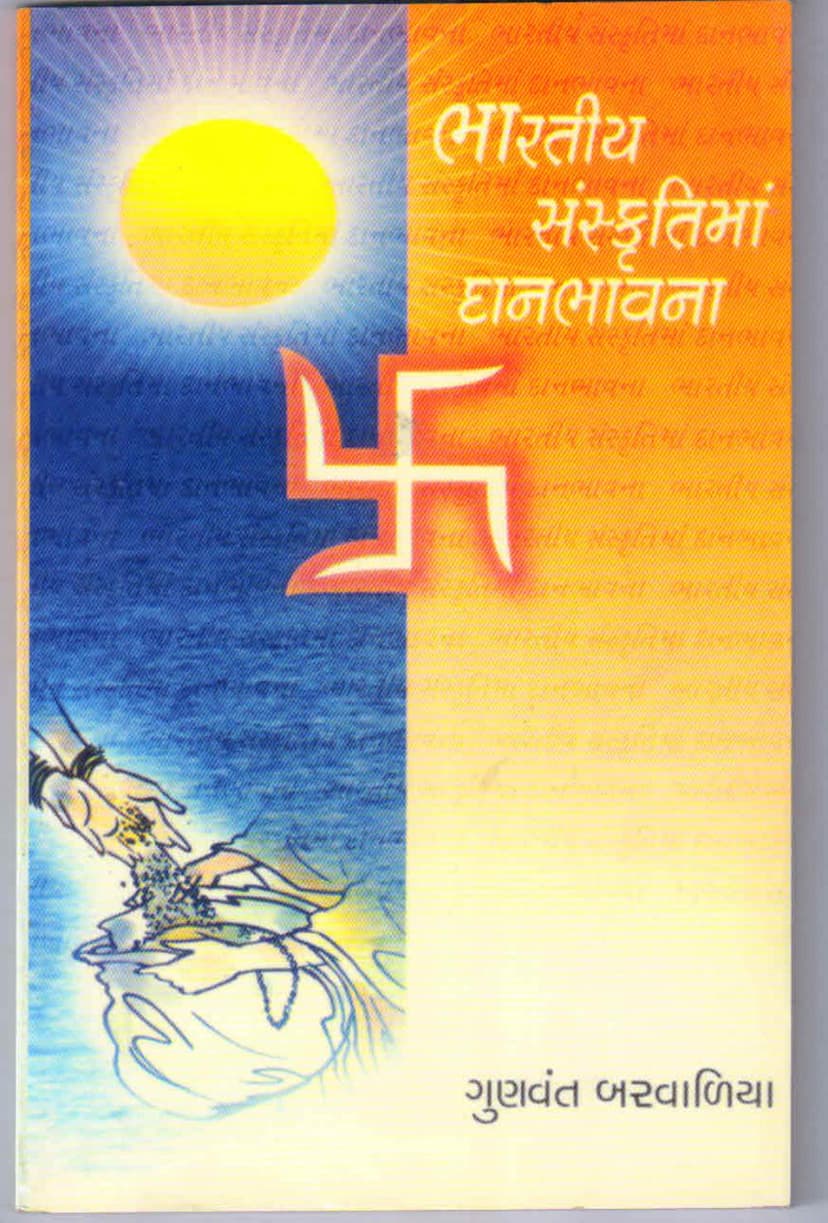Bharatiya Sanskritima Dan Bhavna
Added to library: September 1, 2025

Summary
Here's a comprehensive summary of the Jain text "Bharatiya Sanskritima Dan Bhavna" by Gunvant Barvalia, based on the provided pages:
This book, "Bharatiya Sanskritima Dan Bhavna" (The Spirit of Giving in Indian Culture), by Gunvant Barvalia, published by Navbharat Sahitya Mandir, explores the profound significance and diverse aspects of 'Dan' (giving/charity/donation) within the framework of Indian culture, with a particular emphasis on Jainism. The text delves into the philosophical underpinnings, practical applications, and exemplary stories of generosity that define this virtue.
Key Themes and Concepts:
- Dan as a Catalyst for Human Development: The book posits that 'Dan' is not merely the act of giving wealth but a powerful means to cultivate noble human emotions like compassion, love, service, and brotherhood. It fosters an awakening of divinity and an experience of divine joy, contributing to the growth of humanity and the spirit of giving.
- The Essence of Dan: Renunciation and Detachment: True success in donation lies in the spirit of renunciation (tyag) and detachment from possessions. The text emphasizes releasing the sense of ownership and ego associated with wealth. True giving means letting go of the "I" and "mine."
- Diverse Forms of Dan: The book highlights various forms of giving, including:
- Ahar Daan (Food Donation): Providing sustenance to the needy.
- Aushadh Daan (Medical Donation): Offering medicine and healthcare.
- Abhay Daan (Fearlessness Donation): This is considered the highest form of donation, encompassing compassion for all living beings (Jivdaya).
- Gyan Daan (Knowledge Donation): Sharing knowledge, wisdom, and spiritual insights, with saints, teachers, and parents being esteemed givers.
- Qualities of a True Giver: The text stresses the importance of the giver's intent and mindset. Giving should be done with happiness and a sense of duty, not for recognition or ego gratification. The donor should feel lightened after giving, much like expelling waste.
- The Importance of "Supatra Daan" (Giving to the Worthy): While all giving is considered good, the book emphasizes the significance of giving to those who are deserving and will utilize the donation for virtuous purposes. This aligns with the Jain philosophy of directing resources towards spiritual upliftment and the welfare of the righteous.
- The Analogy of the Cloud: The text uses the metaphor of clouds to categorize givers: those who thunder but don't rain (talk about charity but don't give), those who rain but don't thunder (give without announcing), those who thunder and rain (give and announce), and those who neither thunder nor rain (neither give nor announce).
- Dan as a Means of Liberation and Merit: Giving is presented as a noble deed (satkarma) that reduces attachment and greed. It is a pathway to spiritual merit and can help in breaking the cycle of birth and death.
- The Value of Sincere Giving: The book underscores that even a small donation made with sincere intention and a pure heart holds immense value. Examples like the seven 'damdis' donated by Bhimashah are cited to illustrate how the spirit of giving transcends the monetary value.
- The Impact of Giving: True giving can transform lives, change hearts, and alleviate poverty. It can act as a form of penance and open the doors to happiness and welfare. The book draws parallels with the concepts of investment in bonds, suggesting that wealth given in charity yields manifold returns across lifetimes.
- Ethical Considerations in Giving: The text touches upon the importance of Saadhan Shuddhi (purity of means) in acquiring wealth and the need for accountability in managing donated funds by institutions. It warns against using charity as a means to cover sins.
- Renunciation of Ownership and Ego: A core message is the necessity of relinquishing ownership (swatva) and lordship (swamitva) over the donated items. True donation involves the detachment of the "I" and "mine."
- Examples of Great Givers: The book celebrates numerous historical and legendary figures known for their immense generosity, including Bhimashah, Karn, Bali Raja, Jagdusha, Bhamashah, and Jawadshah. It also draws examples from other traditions and modern times, like Mother Teresa and Bill Gates, to showcase the universal nature of giving.
- The Power of Intention: The book repeatedly emphasizes that the spirit and intention behind the donation are paramount. Giving with joy, humility, and a desire for the welfare of others is what truly defines the act of charity.
- The Analogy of the Milk-Roti: A powerful anecdote illustrates how a simple roti, offered with pure devotion and selfless intent, is more valuable than opulent food offered with ego. It highlights that the 'sweat of labor' and purity of intention imbue wealth with true value.
- Timeliness of Giving: The concept of 'Tarata Daan' (immediate giving) is highlighted as a virtue, urging individuals not to postpone acts of charity. The story of Yudhishthira's delay in giving and Bhima's response illustrates this point.
- The Everlasting Nature of True Donation: The book suggests that wealth truly belongs to us only when it is given away for noble causes, as it becomes a "traveler's check" for the soul across lifetimes.
In essence, "Bharatiya Sanskritima Dan Bhavna" is a rich exploration of charity as a cornerstone of Indian culture, particularly within Jainism. It provides a moral and philosophical framework for understanding giving, not just as an act of philanthropy, but as a spiritual practice that refines character, fosters well-being, and ultimately leads to liberation. The book inspires readers to cultivate a spirit of selfless giving, emphasizing that the true measure of wealth lies not in its accumulation, but in its benevolent distribution for the betterment of oneself and society.